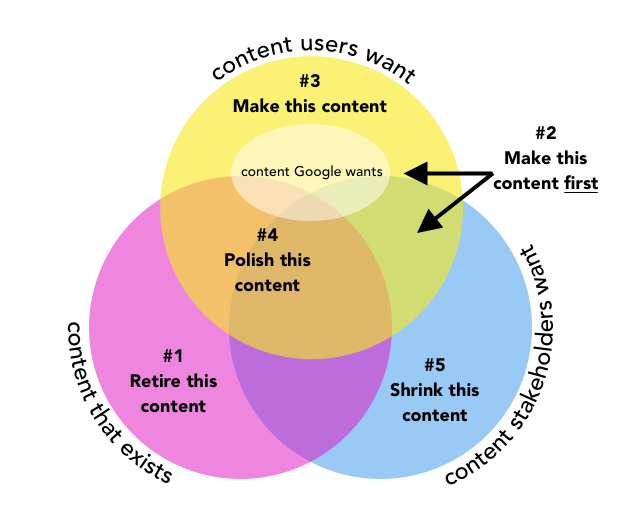The Handy-Dandy Content Audit Template
All you need to do is sort your findings into these 5 simple recommendations. You're welcome.

Okay, this template (which I first made in 2011) is partly tongue-in-cheek as an oversimplification, but it nevertheless represents a solid approach for organizing your recommendations. Follow it and much of the time you’ll be right on the mark.
While the purpose of every audit will vary, the point of the “Handy-Dandy Template” is to remind us:
The purpose of an audit is to make prioritized recommendations about what we need to do.
A good audit articulates a concrete content program for making the user/customer experience better and meeting important business goals.
- The first priority is clearing out the dross. What is in the way that should be removed? Content that exists but nobody wants. The reason I put this first is because unwanted content bogs you down. When untended, it grows and becomes such a beast to manage that it gets in the way of the stuff that actually matters. But if you prioritize getting rid of the ROT (Redundant, Obselete, Trivial), you free up time and resources so you can make real progress.
- Next, we put the goals of our audience of users first. Where are the gaps? What do your users need that they don’t have? Start where those gaps coincide with key business and (internal) constituent goals that aren’t being met. At the same time, pay attention to the content that is critical to Google and other search engines, because that will likely have an unambiguous impact.
- Beyond the first early wins, you can plan out a sustained program of user-focused content to develop over time. This is your opportunity for roadmapping a one- to two-year editorial calendar. In your audit, take a stab at topics and formats that can inspire some creative concepts.
- Then there is the content you have but that needs a little polishing. Some may just need simple updating, and some may require wholesale rewrite. Are there gems that can be enhanced? There’s often content that will be better in a different format. There may be articles which can be supplemented with better visuals or with video. Large items may be broken into more digestible parts. Lay out what kinds of polishing you recommend for specific items.
- Lastly, there’s the stuff that folks in the business love but that your audience doesn’t really care about. Those PDF whitepapers that get 1 hit a month. The videos with only a dozen views. Every organization has them. Keep in mind these materials are the lowest priority for your audit. Don’t get too hung up on them; you’re just making sure to cover all bases.
Find out who owns this content. Chances are, some of it has been orphaned, and that’s the stuff that is easiest to remove. Find out whether any of these unpopular documents are there for legal reasons, and what the requirements are for maintaining them. For the stuff you can’t get rid of, look for ways to place it where it can do no harm. The goal is to shrink what you can’t easily remove.
And take care here, since these are sometimes the organization’s (or a particular executive’s) sacred cows. Egos may be on the line, and you don’t want to sabotage all the other good work you’ve done just to die on the hill of fighting against “content only a VP could love.”

